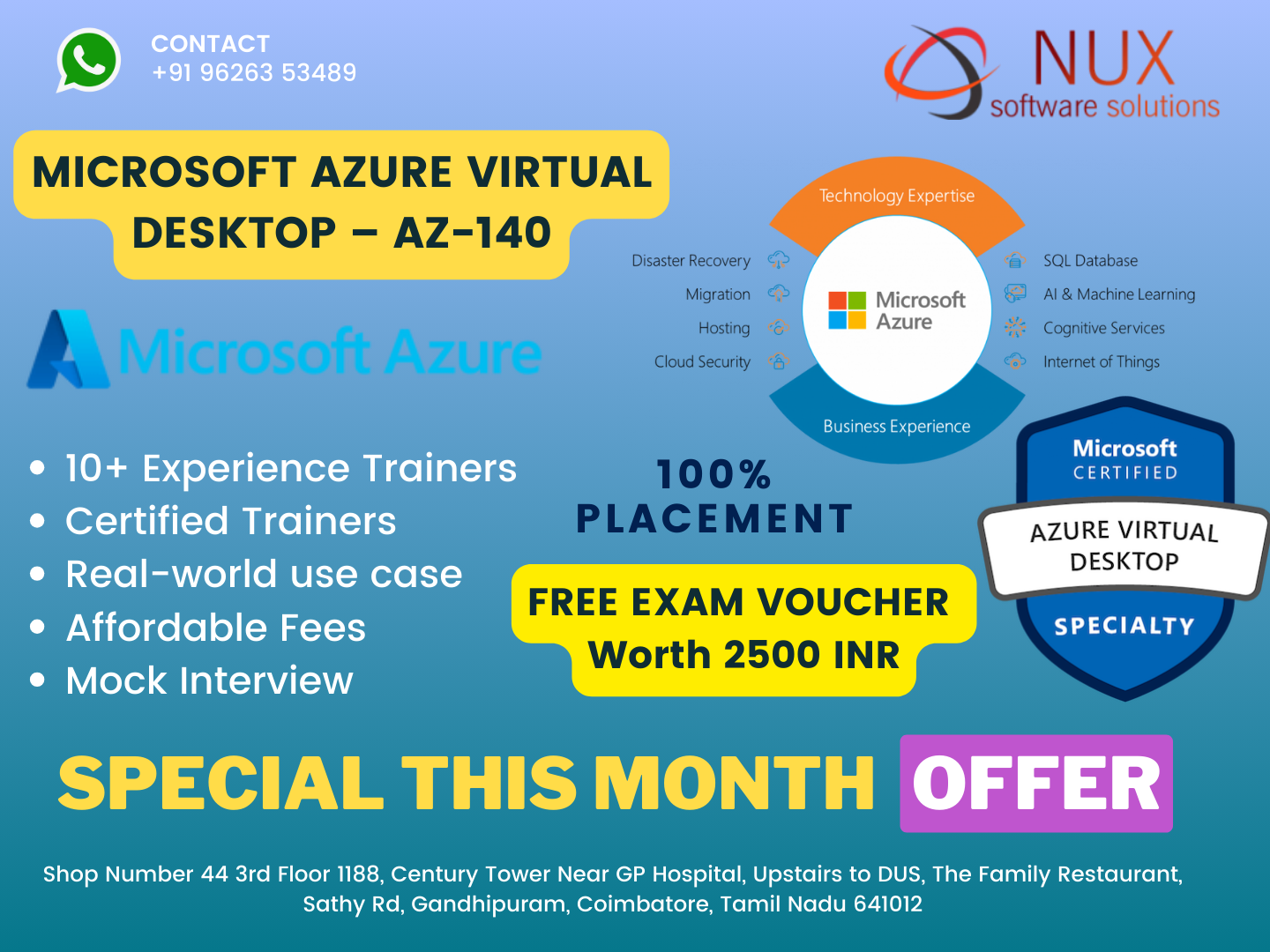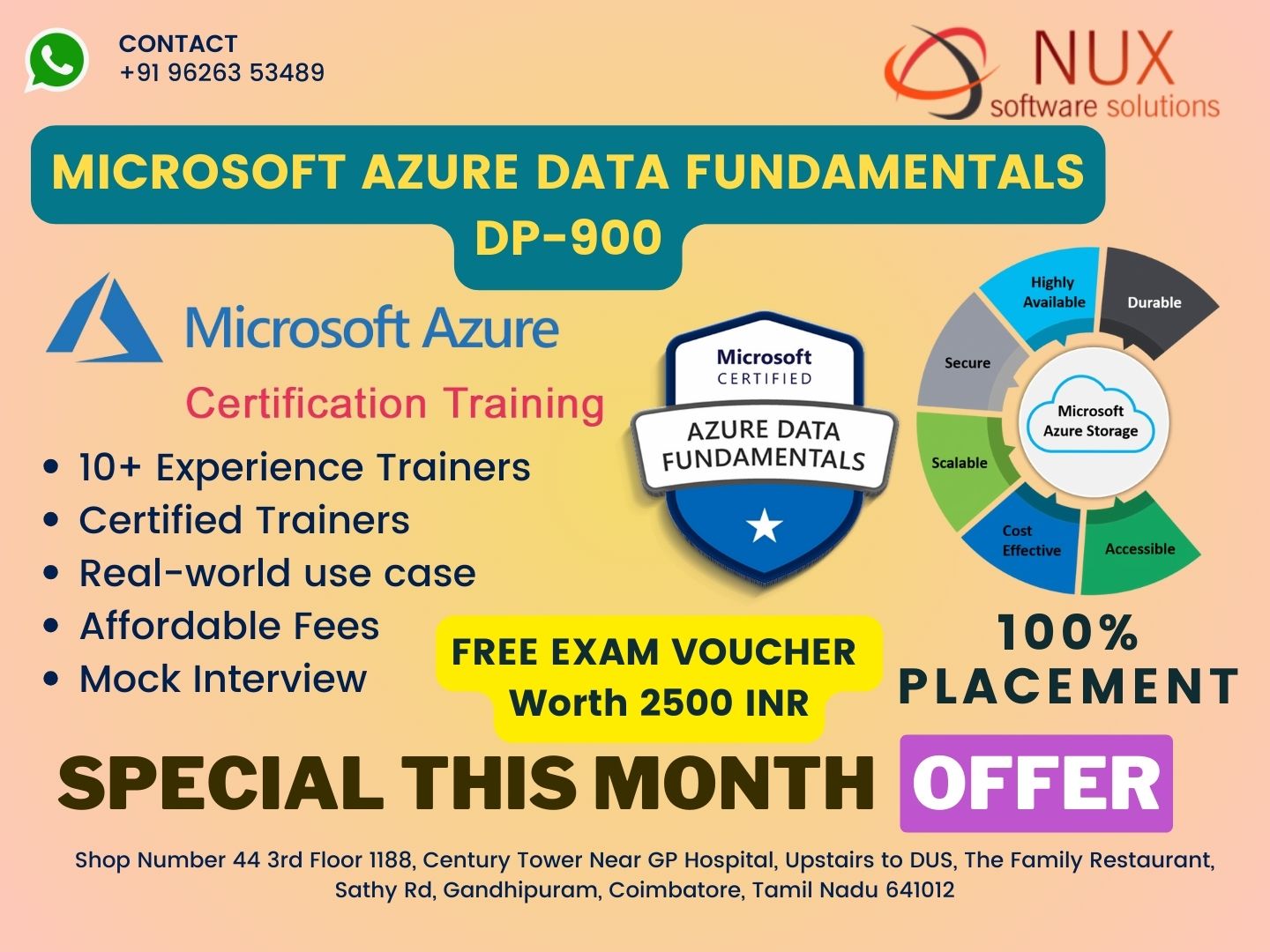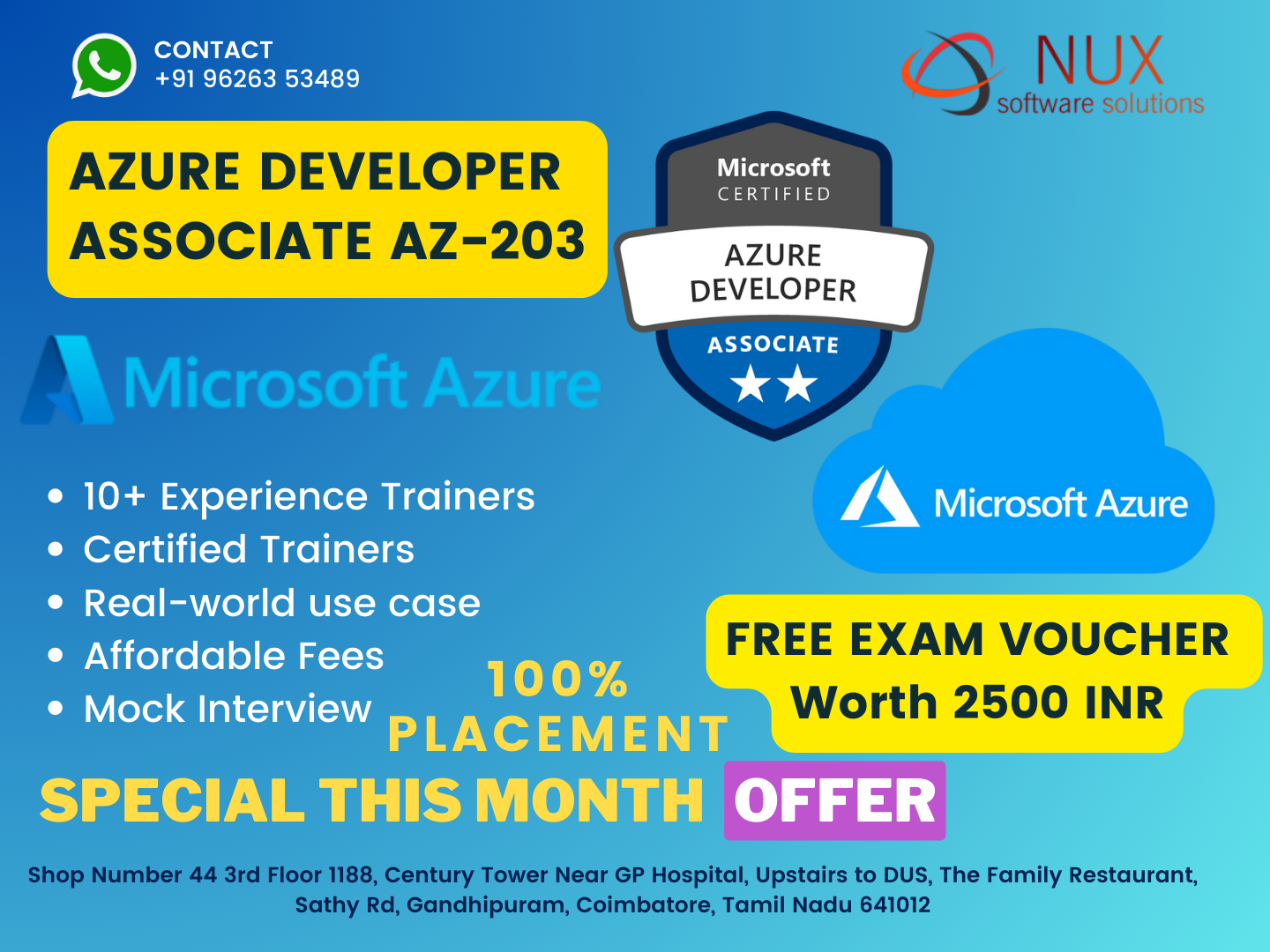Microsoft Azure Virtual Desktop – AZ-140


Microsoft Azure Virtual Desktop – AZ-140 is one of the best cloud solutions available and in order to be an expert on this particular application Nux software Solutions is your one-stop destination. Over the years, we have been one of the premium institutes when it comes to rendering quality training in various domains of IT. We have a team of experts and highly qualified faculties who have been rendering quality training to our students.
The Microsoft Azure Virtual Desktop – AZ-140
At Nux software Solutions, we have designed a highly customized and effective course material that is based in lab work and lots of hands-on application. We have made sure that our students got maximum practical exposure that would help them to achieve their goals in the professional fields.
Course Syllabus
Module 1 - Plan and implement an Azure Virtual Desktop Infrastructure (40-45%)
Plan, implement, and manage networking for Azure Virtual Desktop
Module 2
- Assess network capacity and speed requirements for Azure Virtual Desktop
- Calculate and recommend a configuration for network requirements
- Plan and implement Azure virtual network connectivity
- Manage connectivity to the internet and on-premises networks
- Plan and implement RDP Shortpath and quality of service (QoS) policies
- Plan and implement name resolution for Azure Virtual Desktop
- Monitor and troubleshoot network connectivity
Module 3 - Plan and implement storage for Azure Virtual Desktop user data
- Plan storage for Azure Virtual Desktop user data
- Implement storage for FSLogix components
- Implement storage accounts
- Implement file shares
- Implement Azure NetApp Files
Module 4 - Plan host pools and session hosts
- Recommend resource groups, subscriptions, and management groups
- Recommend an operating system (OS) for an Azure Virtual Desktop implementation
- Design and implement an SAP migration to Azure
- Recommend an appropriate licensing model for Azure Virtual Desktop based on requirements
- Plan a host pools architecture
- Calculate and recommend a configuration for performance requirements
- Calculate and recommend a configuration for Azure Virtual Machines capacity requirements
Module 5 - Implement host pools and session hosts
- Create host pools and session hosts by using the Azure portal
- Automate the creation of Azure Virtual Desktop hosts and host pools by using PowerShell, Azure CLI, Azure Resource Manager templates (ARM templates), and Bicep
- Configure host pool and session host settings
- Apply a Windows client or Windows Server license to a session host
Module 6 - Plan and implement identity and security (15-20%)
Plan and implement identity integration - Choose an identity management and authentication method.
- Identify Azure Virtual Desktop requirements for Active Directory Domain Services (AD DS), Azure Active Directory Domain Services (Azure AD DS), and Microsoft Azure Active Directory (Azure AD), part of Microsoft Entra
- Plan and implement Azure roles and role-based access control (RBAC) for Azure Virtual Desktop
- Plan and implement Azure AD Conditional Access policies for connections to Azure Virtual Desktop
- Plan and implement multifactor authentication in Azure Virtual Desktop
- Manage roles, groups, and rights assignments on Azure Virtual Desktop session hosts
Module 7 - Plan and implement security
- Plan, implement, and manage security for Azure Virtual Desktop session hosts by using Microsoft Defender for Cloud
- Configure Microsoft Defender Antivirus for session hosts
- Implement and manage network security for connections to Azure Virtual Desktop
- Configure Azure Bastion or just-in-time (JIT) for administrative access to session hosts
- Plan and implement Windows Threat Protection features on Azure Virtual Desktop session hosts, including Windows Defender Application Control
Module 8 - Plan and implement user environments and apps (20-25%)
- Plan and implement FSLogix
- Recommend FSLogix configuration
- Install and configure FSLogix
- Configure Profile Containers
- Configure Office Containers
- Configure Cloud Cache
Module 9 - Plan and implement user experience and client settings
- Choose an Azure Virtual Desktop client and deployment method
- Deploy and troubleshoot Azure Virtual Desktop clients
- Configure printing and device redirection
- Configure user settings through Group Policy and Microsoft Endpoint Manager policies
- Configure Remote Desktop Protocol (RDP) properties on a host pool
- Configure session timeout properties
- Implement the Start Virtual Machine on Connect feature
- Assign and unassign personal desktops for users
Module 10 - Install and configure apps on a session host
- Choose a method for deploying an app to Azure Virtual Desktop
- Configure dynamic application delivery by using the MSIX app and attach
- Publish an application as a RemoteApp
- Implement FSLogix application masking
- Implement and manage OneDrive, including multisession environments
- Implement and manage Microsoft Teams, including AV redirect
- Implement and manage Microsoft 365 apps on Azure Virtual Desktop session hosts
- Implement and manage browsers for Azure Virtual Desktop sessions
- Create and configure an application group
- Assign users to application groups
Module 11 - Monitor and maintain an Azure Virtual Desktop Infrastructure (10-15%)
- Monitor and manage Azure Virtual Desktop services
- Configure log collection and analysis for Azure Virtual Desktop session hosts
- Configure Azure Virtual Desktop monitoring by using Azure Monitor
- Monitor Azure Virtual Desktop by using Azure Monitor
- Customize Azure Monitor workbooks for Azure Virtual Desktop Monitoring
- Monitor Azure Virtual Desktop by using Azure Advisor
- Optimize session host capacity and performance
- Implement autoscaling in host pools
- Monitor and manage active sessions and application groups
- Configure automation for Azure Virtual Desktop
- Automate management of host pools, session hosts, and user sessions by using PowerShell and Azure CLI
Module 12 - Plan, implement, and maintain business continuity
- Recommend an update strategy for session hosts
- Plan and implement a disaster recovery plan for Azure Virtual Desktop
- Plan for multi-region implementation
- Design a backup strategy for Azure Virtual Desktop
- Configure backup and restore for FSLogix user profiles, personal virtual desktop infrastructures (VDIs), and golden images


